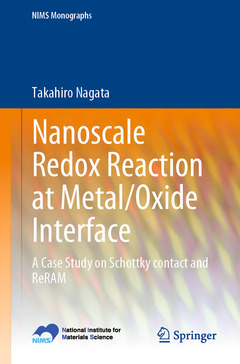Description
Nanoscale Redox Reaction at Metal/Oxide Interface, 1st ed. 2020
A Case Study on Schottky Contact and ReRAM
NIMS Monographs Series
Author: Nagata Takahiro
Language: English
Subjects for Nanoscale Redox Reaction at Metal/Oxide Interface:
Approximative price 52.74 €
In Print (Delivery period: 15 days).
Add to cart89 p. · 15.5x23.5 cm · Paperback
Description
/li>Contents
/li>Biography
/li>Comment
/li>
Oxide materials are good candidates for replacing Si devices, which are increasingly reaching their performance limits, since the former offer a range of unique properties, due to their composition, design and/or doping techniques.
The author introduces a means of selecting oxide materials according to their functions and explains metal/oxide interface physics. As he demonstrates, material development is the key to matching oxide materials to specific practical applications.
In this book, the investigation and intentional control of metal/oxide interface structure and electrical properties using data obtained with non-destructive methods such as x-ray photoelectron spectroscopy (XPS) and x-ray reflectometry (XRR) are discussed. Further, it shows how oxide materials can be used to support the development of future functional devices with high-k, ferroelectric, magnetic and optical properties. In closing, it explains optical sensors as an application of metal Schottky contact and metal/oxide resistive random access memory structure.
Takahiro Nagata is a Group Leader at the Research Center for Functional Materials, National Institute for Materials Science (NIMS). He received his Ph.D. from Osaka Prefecture University in 2003. He joined NIMS as a Researcher at the Advanced Electric Materials Center in 2006, was appointed a Senior Researcher in the Semiconductor Device Materials Group at MANA in 2011, and has served in his current position since 2018. He was also a Visiting Scientist at the Department of Materials, University of California Santa Barbara in 2008-2009. Currently he is also a Visiting Professor at the Graduate School of Science and Technology, Meiji University.
His work focuses on developing combinatorial synthesis systems and high-throughput characterization tools for screening candidate materials in the context of materials informatics. Most recently, he has begun expanding his focus to nanoelectronics materials, including wide band-gap semiconductors.
Describes the use of interface control to maximize the potential of materials in nanoscale phenomena
Introduces the combinatorial synthesis method for thin film growth used in the optimization of numerous multi-component functional materials
Explains analysis methods combining angle-resolved measurements and hard x-ray photoelectron spectroscopy




